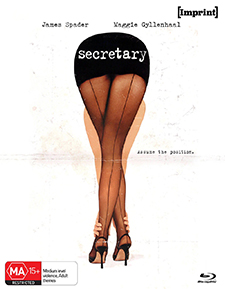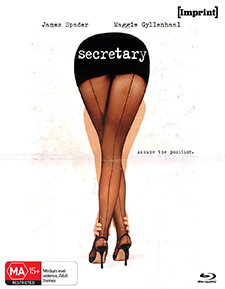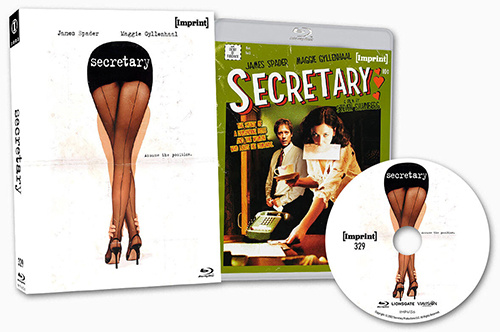Secretary (Blu-ray Review)

Director
Steven ShainbergRelease Date(s)
2002 (July 3, 2024)Studio(s)
Lions Gate Films (Imprint Films/Via Vision Entertainment)- Film/Program Grade: B
- Video Grade: A
- Audio Grade: A
- Extras Grade: A+
Review
[Editor’s Note: This is a Region-Free Australian Blu-ray import.]
Movies deal with all kinds of relationships, some of them subtly destructive (Gaslight), horrifically abusive (What’s Love Got to Do with It), homicidal (Badlands), or socially difficult (Brokeback Mountain). In Secretary, an employer and employee find in each other a bizarre yet fulfilling connection.
Lee Holloway (Maggie Gyllenhaal, The Dark Knight), recently released from a sanitarium, where she has completed treatment for self-cutting, is nervous about re-entering the world and socializing. Eager to get her life as close to normal as possible, she looks for work and finds a law firm’s newspaper want ad for a secretary. Armed with a document from typing school noting her impressive speed, she applies in person.
Lee is a novice in the work force and eager to please. During the job interview with her potential new boss, Edward Grey (James Spader, Wall Street), he asks inappropriate questions about her private life and she answers them. He warns her she’s overqualified and the job is dull, and she responds, “I like dull work.” She’s hired.
Determined to please her boss, she puts up with demeaning tasks, such as searching through a dumpster for notes Grey accidentally threw out and complying without question to his increasingly odd requests, such as crawling on hands and knees with papers in her mouth and conducting office tasks handcuffed to a spread bar across her shoulders. In her off-hours, she has a friendly relationship with Peter (Jeremy Davies, Intimate Affairs), one his parents hope will lead to marriage. But it’s Grey who’s the object of her fascination. At one point, he sees her readying her treasured “cutting kit” at the office. He orders her never to cut herself again and she later chucks it into the river.
The relationship between Lee and Grey escalates into full-fledged domination/submission that satisfies a need in each of them. Lee becomes less dependent on her mother (Lesley Ann Warren, Victor/Victoria), develops a growing sense of self-worth, and sees herself as a sexually attractive woman.
Based on a short story by Mary Gaitskill, the script by Erin Cressida Wilson chronicles the Lee/Grey connection in steps, one more bizarre than the next. The look on Lee’s face conveys that Grey’s orders and even his harsh words are a turn-on, as if they validate her existence, and make her increasingly eager to please. Seeing this, Grey creepily savors his control over Lee. Whenever one would think a line has been crossed, the odd couple move to a higher level of weirdness.
Gyllenhall projects a combination of vulnerability and innocence developing into self-assurance as the office gamesmanship escalates. Her Lee is a wounded soul in need of structure. Grey provides it in his peculiar way and she responds, surprising both herself and her employer. From an objective point of view, she’s being abused terribly, but is she really if she gains pleasure and self-confidence from it? That question is what makes Secretary so fascinating.
Spader has no trouble convincing us that his Grey is a predator who uses his power as the boss to intimidate and demean his unsuspecting employee and play what appear to be destructive mind games to break her spirit. That she doesn’t immediately quit indicates she’s the perfect underling, compliant and submissive, willing do just about anything to please him.
Director Steven Shainberg has elicited outstanding performances from the two leads in a film that may well have been ahead of its time. He makes this very dark material intriguing and induces us to feel empathy not only for Lee but also, maybe to a lesser degree, for Grey. Both are on society’s fringe yet manage to lead normal lives. Their safe place is the office, where they can become their true selves without judgment or accountability. Shainberg handles the subject matter with sensitivity. His focus is on the characters and he lets us see them as real people, not merely puppets manipulated to present controversial subject matter.
The film is filled with surreal touches. Outside Grey’s office building is a large “Secretary Wanted” sign surrounded by movie marquee-type lights that looks pretty permanent. Peter takes Lee on a dinner date to a laundromat with elegant tables and waiter service. Lee’s mother waits for hours outside Grey’s office to give her daughter a lift home. There seems to be hardly anyone else working at the law office. And one of Lee’s dreams places her as part of a giant blooming flower. These scenes give the story a kind of fairy-tale quality.
Secretary was shot on 35 mm film by director of photography Steven Fierberg with Arriflex 535B cameras with Cooke S4 lenses and presented in the aspect ratio of 1.85:1. The aspect ratio of the Blu-ray from Imprint Films is 1.78:1. Contrast and clarity are both excellent. The color palette is broad, ranging from Lee’s purple blouses to Grey’s conservative dark suits. Grey’s office is fairly dark with accent lighting on the walls and from lamps, so it appears more like a sanctuary than a working office space. The red walls suggest forbidden danger. Most of the film takes place within Grey’s office. In fact, the screenplay could easily be adapted for the stage. Shainberg’s blocking is slow and deliberate. He creates an inevitable, almost hypnotic sense of movement rather than spontaneity, suggesting the control Grey wields over Lee.
The soundtrack is English 2.0 LPCM. Optional English SDH subtitles are available. Dialogue is clear and distinct. James Spader speaks at a low volume that gives his delivery a decidedly creepy feel. Gyllenhaal’s submissive and self-effacing Lee speaks in short sentences or phrases. Much of her performance is visual, consisting of reactions that show Lee’s state of mind. A brief wedding scene contains the usual sounds of a party with people talking, laughing, and ambient music serving as background as characters speak. Angelo Badalamenti’s score is seductive as it accompanies the strange goings-on in Grey’s inner sanctum.
Bonus materials on the Region-Free Blu-ray release from Imprint Films include the following:
- Audio Commentary by Veronica Fitzpatrick
- Audio Commentary by Steven Shainberg and Erin Cressida Wilson
- From Me, But Not Me: Actor Stephen McHattie on Finding the Heart in an Imperfect Father (10:09)
- A Magical Oasis: Art Director Nick Ralbovsky on Building the Stylish, Sensual World of Secretary (16:45)
- Shared Fantasy Producer Andrew Fierberg on Making an Indie Classic (16:54)
- Using Every Light: Director of Photography Steven Fierberg Frames the Humanity of Secretary (22:37)
- James Spader: On-Set Interview (5:47)
- James Spader: Press Interview (6:34)
- Maggie Gyllenhaal: On-Set Interview (7:26)
- Maggie Gyllenhaal: Press Interview (6:47)
- Steven Shainberg Interview (15:03)
- Behind the Secretary (7:09)
- Theatrical Trailer (2:22)
- TV Spots (4:52)
Audio Commentary #1 – Film scholar and editor Veronica Fitzpatrick takes an academic approach to her commentary. She notes differences between the film and the short story on which it’s based. The story featured a walled-in character. Objects in the film represent feelings and emotions. One inspiration of the film was Last Tango in Paris. Fitzpatrick points out impossible point-of-view shots, such as from inside a refrigerator, that suggest voyeurism. Lee’s clothes denote changes in her personality as the film progresses. Fitzpatrick discusses specific set pieces, with cinematography and blocking enhancing the drama. Because Gyllenhaal’s expression doesn’t make clear exactly how Lee feels, this leads to ambiguity. Does it mean she feels a need for clarity, transcendence or longing?
Audio Commentary #2 - Director Steven Shainberg and writer Erin Cressida Wilson share this commentary. Shainberg points out that the opening scene was never scripted. He read about girls who cut themselves because they’re numbed by life. Lee longs for feeling. A key scene between Lee’s parents was moved to an earlier point in the film. There are many images of water in the film because Lee feels she’s submerged but gradually emerging. Set decoration in Grey’s office is discussed and how the items were carefully planned. Mirrors are a mixed blessing; they give the viewer another view, yet the film crew always has to hide from them. Shainberg tells an anecdote about confusion during location shooting that involved the police and quick thinking on the part of Maggie Gyllenhaal. He discusses edits that were made. It was vital to illustrate that Lee is realizing something important is happening between her and Grey. When Grey and Lee are on the same footing, the photography reflects equality. A key final scene leads to a state in which Lee has been through an assortment of experiences. Post-production was a lengthy process. Shainberg makes a point of thanking the people responsible for getting the film made.
From Me, But Not Me – Actor Stephen McHattie, who plays Lee’s father, speaks about his career, including his debut on Broadway in the Edward Albee play The American Dream. He worked in Roger Corman’s film, Von Richthofen and Brown, which introduced him to the “frailties” of moviemaking. A film helicopter collided with one of the stunt planes and lives were lost. Actor Don Stroud crashed into the river and had to be rescued. McHattie also appeared in Tomorrow Never Comes with Oliver Reed. When he read the script for Secretary, he was intrigued and thought it was both funny and curious. Clips from Secretary are shown.
A Magical Oasis – Art director Nick Ralbovsky was looking to get a job in Hollywood. His background was architecture and design. He eventually got work in small films, including Secretary. He found designing a challenge, and had a good relationship with production designer Amy Danger. He felt that the film would be a fun project. The scope was big. The space had to look lush and spacious—“pretty grand.” Plants and floral motifs were added. The decor of Grey’s office is discussed in detail and how various props and articles of set design were selected because they reflected the ardor in Grey’s life.
Shared Fantasy – Producer Andrew Fierberg’s goal was to present the material in a way the audience could relate to while fulfilling the director’s vision. He had done “little things in film” and was looking to build a company and a name for himself. He eventually established a “boutique” production company. He read the Secretary script, visualized a film made from it, and convinced the director the script was a comedy. No one wanted to produce, finance, or act in it. They needed a “bankable” actor or actress. Reese Witherspoon and Ray Liotta were originally cast, but that didn’t last long. James Spader finally agreed to star.
Using Every Light – Director of photography Steven Fierberg worked on film noir punk movies, learning how to light from experts. He worked lighting sets for free, since not a lot of people in New York knew how to light. He shot additional scenes for Sid & Nancy to match the work of Roger Deakins, and shot Forty Deuce, directed by Paul Morrissey. Fierberg notes that’s it’s important to have an image of what the film should look like before filming begins. The props in Grey’s office should be dark, the room gloomy. Director Shainberg, however, felt the office is where Lee is happiest. Fierberg speaks about specific film stocks used to achieve particular effects. As Lee achieves happiness, Fierberg uses the telephoto lens more and more. The progression of the lighting scheme is a subtle way of contributing to a character’s state of mind. Shainberg was initially very specific in his direction but Spader took issue, noting he needed time to experiment and work his way into the character. To compromise, Shainberg agree to shoot each scene two ways.
James Spader Interviews – In these on-set and press interviews, James Spader discusses the screenplay of Secretary, the film’s humor, the character of Edward Grey, and how he approaches a role. He believes having the right temperament for a role is helpful in making it come alive.
Maggie Gyllenhaal Interviews – Gyllenhaal was immediately drawn to the script because it’s provocative and it’s about a woman. She was also a little scared of it. Initially, Lee is in a very dark place and depressed. She’s just come out of an institution because she attempted suicide. She discovers that life is made up of both joy and pain.
Steven Shainberg Interview – Shainberg made a short film based on the short story and felt it could be expanded into a feature. He met with many people who never grasped the essence of the story. No one would touch it. Six or seven years later, Shainberg finished the script, making it about something mysterious. He refers to Secretary as a dark coming-of-age story. Something perceived as odd isn’t. It’s just a part of ordinary life, and Lee has to discover this for herself.
Behind the Secretary – Clips from Secretary are shown along with brief comments from director Steven Shainberg and actors Maggie Gyllenhaal and James Spader.
Secretary, a psychosexual drama, uses a sadistic/masochistic relationship as a means for a young woman’s climb from despair to an unorthodox form of happiness. Still powerful 22 years after its initial release, the film peers behind the privacy of office doors to portray a seemingly oddball romance in the making. With first-class performances by Spader and Gyllenhaal, the film balances themes of obsession, dehumanization, and sensuality through a lens that views them as pathways to a normal life. Lee and Grey are two imperfect people searching for a place in the world. The subject matter is dark but often humorous in places, and the two moods don’t always blend smoothly. This isn’t likely to be the kind of film that a broad audience would embrace.
- Dennis Seuling


